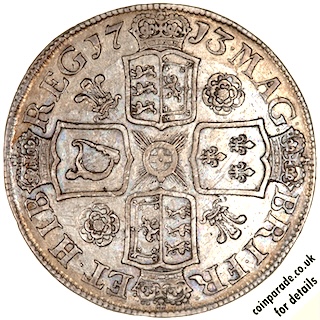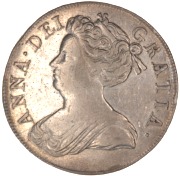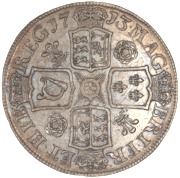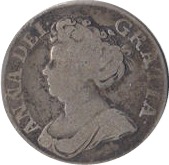
 The 1713 Crown - Anne (DVODECIMO)
The 1713 Crown - Anne (DVODECIMO)Silver Crown (5 shillings) of Queen Anne, minted at the Royal Mint in London in 1713. Third bust. Roses and Plumes. SCBC: 3603.
Diameter 38mm, weight 29.825g.
The Obverse shows the draped bust of Anne. Legend around is "ANNA DEI GRATIA".
Edge inscription is "DECVS ET TVTAMEN ANNO REGNI DVODECIMO" in raised lettering.
 The Reverse shows crowned shields of arms of England and Scotland, Ireland, and France. Badge of the Star of the Garter at centre. Between the shields are two roses and two plumes. Legend around is "MAG BRI . FR ET . HIB REG 1713". Date is divided across the top crown.
The Reverse shows crowned shields of arms of England and Scotland, Ireland, and France. Badge of the Star of the Garter at centre. Between the shields are two roses and two plumes. Legend around is "MAG BRI . FR ET . HIB REG 1713". Date is divided across the top crown.Image credit: Museums Victoria
Mintage: Not known
Minted at The Royal Mint
More information (monarch, year, mint, country, category) can be found below coin listings.
Below are some coins currently being offered on eBay. As an eBay Partner, We may be compensated if you make a purchase.
List items on:
List items on:
Anne (1702-1714)
 Anne became Queen of England, Scotland and Ireland on 8 March 1702. On 1 May 1707, under the Acts of Union, two of her realms, the kingdoms of England and Scotland, united as a single sovereign state known as Great Britain. Some of these post-Union coins have an 'E' below the bust for Edinbugh Mint.
Anne became Queen of England, Scotland and Ireland on 8 March 1702. On 1 May 1707, under the Acts of Union, two of her realms, the kingdoms of England and Scotland, united as a single sovereign state known as Great Britain. Some of these post-Union coins have an 'E' below the bust for Edinbugh Mint.Born Anne Stuart, the daughter of James II, she became Queen after the death of William III. Anne was the last of the Stuarts and became the first monarch of the newly formed United Kingdom of Great Britain.
Some coins have "VIGO" on them, meaning they were minted from bullion captured from the Spanish fleet at Vigo Bay. They can be quite rare and expensive.
The regnal years for Queen Anne coins were:
1703:SECVNDO; 1705:QVARTO; 1706:QVINTO; 1709:OCTAVO; 1711:DECIMO; 1713:DVODECIMO; 1714:DECIMO TERTIO.
Category: Crowns
The Crown is a very old coin, with origins dating back to Henry VIII. The English Crown first appeared in 1526. It was made of 22 carat gold ("crown gold") and has a value of five shillings (a quarter of a pound).By 1551, silver was being used to produce crowns, although gold was sometimes still used. The silver crown was quite large, being about 38mm and weighing about one ounce. Around that time many Europeans countries had similar sized silver coins which made them good for international trade as they were essentially interchangeable.
The metal used was 92.5% silver and the rest copper so as to make the coin harder. This hardness, together with a milled edge, made 'clipping' (which was cutting slices off the edge to steal some free silver) more difficult.
After the Union of England and Scotland in 1707 a new coin, the British Crown, replaced the English Crown and Scottish Dollar. The value was set at 5 shillings and the size was 38mm in diameter and weighed about 1oz as before.
Now more of a commemorative coin
Although the coin was always part of the British coin family, its large size made it unpopular for general circulation and the half-crown was favoured as the de-facto largest coin in circulation. The Crown was more-or-less relegated to a commemorative coin.
The British economy, especially after the World Wars, took its toll on the crown too. From 1816-1919 the crown was 0.925 silver, this was reduced to 0.500 silver in 1920 and in 1947 the Crown became Cupronickel (75% copper, 25% nickel). The size standardised at 38.61 mm and (silver crown) weight of 28.276g (1 oz).
Although not in current circulation, the Crown is still legal tender. After decimalisation in 1971 the Crown was officially valued at 25 pence. In the Eighties we had inflation which brought in higher denomination coins like the pound coin and the two-pound coin, so the Government decided that the crown needed to be restored to it former glory as biggest denomination coin and the crown was re-denominated to £5 in 1990.
Today the Crown is once again made in silver and gold, usually to satisfy collectors and investors. There is a little confusion with this as there are Gold Crowns which are worth £5 but there is another five-pound Gold coin from the sovereign family - see the article on Gold £5 Coin or Gold Crown?
Which Mint: The Royal Mint
The Royal Mint is the designated place for the UK to mint coins. It dates back well over 1000 years and is a Government-owned company. Formed in the reign of Alfred the Great about the year 886, during the period 1279-1812 it was generally referred to as The Tower Mint as it was housed at the Tower of London. The Master of The Royal Mint has included famous figures such as Sir Isaac Newton.
Since 2010 it has operated as Royal Mint Ltd, a company owned by HM Treasury, under an exclusive contract to supply all coinage for the UK although it also produces medals and coins for other countries. It is currently located at Llantrisant, Wales.
Country of Origin: United Kingdom
The United Kingdom (UK) is the Union of England, Scotland, Wales and Northern Ireland. It is often refered to as Great Britain (GBR). It has a long, rich history. The orignal coinage was Pounds, Shillings and Pence but since decimalisation on 15 February 1971, it is £1 = 100p, that is One Pound = 100 pence. The coinage of the UK is also a long history, the Royal Mint being established as long ago as 886AD when coins were hammered. Today there is perhaps 30 billion coins in circulation, and many (numismatic) collectors coins and sets are issued frequently in gold, silver and other metals.








